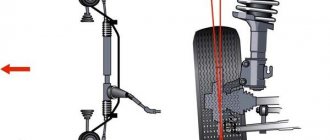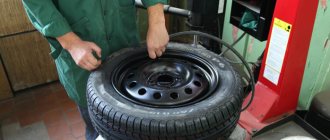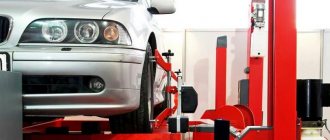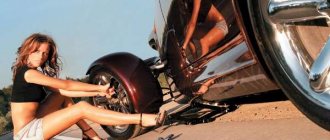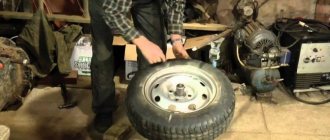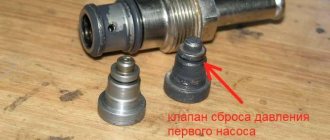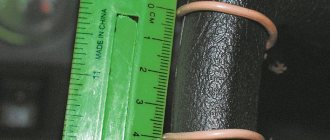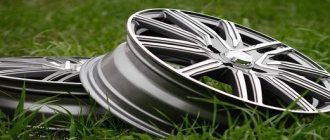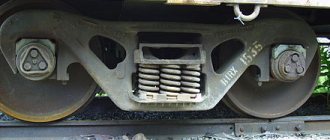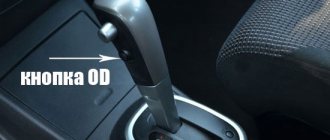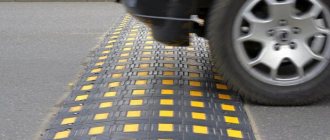The behavior of a car on the road is determined by many factors, the main ones of which are the design of its suspension, the type and size of tires, as well as the angles of the front wheels. By the way, not only how the car behaves on the road, but also the wear of tires and suspension elements depends on the latter.
To keep rolling resistance to a minimum, the front wheels of the car must rotate in vertical planes, parallel to the longitudinal axis of the car. However, in order to increase the stability of the car, improve handling and ensure that, after turning, the steered wheels return independently to a position that corresponds to straight-line motion, the front wheels are installed at certain angles relative to each other and the car body.
As the vehicle is used, the angle values change and go beyond the permissible limits established by the manufacturer. If the adjustments are not too much, the driver may not notice it for a long time. As the problem worsens, the car will constantly pull to the side when moving in a straight line, uneven tire wear will begin, etc.
To avoid such problems, periodic checking and adjustment of the front wheel alignment angles is required. It is advisable to carry out these procedures at least once every 30 thousand km, as well as after strong impacts on the chassis (for example, after a wheel hits a hole at high speed).
What angles need to be adjusted?
Checking and adjusting wheel alignment angles is carried out according to three parameters described below.
Castor
This is the angle of longitudinal inclination of the wheel's turning axis relative to the vertical. Its value can be either positive or negative. Thanks to the castor, the front wheels tend to return to neutral on their own. It determines the change in wheel camber when turning the steering wheel and the stabilization of the car when moving in an arc. The higher its value, the stronger the stabilizing effect.
When the steering wheel is turned, the wheels tilt in the direction of the turn, providing the aforementioned stabilizing effect. The castor value on modern rear-wheel drive cars can reach 10-12 degrees, on cars with front-wheel drive the castor is set less, about 5-8 degrees.
Wheel alignment
This value can also be either positive if the lines drawn along the steered wheels intersect in front of the car, or negative if the intersection point is behind. It should be noted that the closer the toe angle is to zero, the less rolling resistance the machine experiences.
Article on the topic: Causes of steering wheel vibration when driving, braking and idling
Negative toe-in is an extremely undesirable phenomenon. It causes deterioration in handling, worse response to the steering wheel leads to the car yaw along the road and increases the risk of an uncontrolled skid.
With positive toe-in of the steering wheels, the car responds better to steering inputs, turns easier, and, in addition, gains additional steering ability. The rear axle wheels are also installed with positive toe-in, as a result the car becomes more stable when moving in a straight line.
If the toe angles deviate greatly from the norm, increased sawtooth wear of the tire tread occurs:
- if positive – its outer part;
- if negative – internal.
Wheel camber
Camber is the angle between the vertical and the plane of rotation of the wheel. If the wheels are tilted toward the center of the car, the camber angle is negative; when tilted outward, the camber angle is positive. Deviation of camber angles from the norm leads to increased wear of the tread; in addition, the car will constantly be pulled towards the wheel with a larger camber angle.
We adjust the wheel alignment yourself
Before you begin the procedure for checking corners, you need to prepare your workplace and tools. A suitable place is a flat area with an inspection hole. Instruments required for the procedure include:
- Chalk.
- A simple ruler.
- A cord with a weight attached to the end.
You will need to attach the cord to the car to take measurements.
- Set of hex keys.
You won't be able to adjust the angles without the keys.
- Telescopic ruler.
A telescopic ruler is necessary for measuring the toe-in angle of a car's wheels.
In a service station, the procedure for measuring and adjusting wheel alignment, of course, is not done manually, but using expensive computer equipment, but for a home workshop, purchasing such devices is not financially feasible.
Wheel camber: checking and adjustment
The camber angle is measured using the following algorithm:
- Place the car on a flat surface. Make sure that there is enough space inside the room where the car is located to move it - during the inspection you will have to move the car.
- Align the wheels so that they are level. Place small marks on the top and bottom of the wheels.
- Attach the weighted cord to the wing so that it is parallel to the marks.
- Using a ruler, measure the distance from the wheel to the cord at the top and bottom. The measurement is taken from the wheel rim.
Using a ruler, measure from the cord to the wheel
- Roll the car forward so that the marks move 90 degrees. Make two new marks at the top and bottom of the wheel, parallel to the cord, and repeat the procedure, measuring the distance.
- Move the machine again so that the marks made the first time rotate 180 degrees, and take the same measurement.
The difference between the values should not be significant: for a front-wheel drive vehicle, a difference of 1 mm is acceptable, for a rear-wheel drive vehicle - 3 mm.
If the difference is greater, an adjustment is required.
- Adjust the steering knuckle by turning the eccentric bolt. How much and in which direction you need to twist will be determined by the measurements taken earlier.
The steering knuckle is adjusted by an eccentric bolt
- Install the jack and remove the wheel.
- Disconnect the strut bracket from the steering knuckle. For this job, a pre-prepared set of hexagons will be useful.
To adjust the camber angle, you need to disconnect the strut bracket from the steering knuckle.
- Connect the bracket to the steering knuckle and return the wheel to its place.
At the end of the procedure, check the correctness of the work.
Wheel alignment: checking and adjustment
The telescopic ruler was not used when correcting the camber angle of the wheels, but it will definitely come in handy when checking the toe-in. The measurement procedure is as follows:
- Park the machine on a level surface.
- Use chalk to make marks on the inside of both tires, closest to the rim.
- Install the telescopic ruler so that its ends touch the marked marks, but the tool itself does not touch the machine parts. Fix the ruler in this position.
To measure the toe angle, you need to fix the telescopic ruler between two marks
- Roll the car forward. The measuring device itself will move backward. Make sure that the ruler does not get caught on anything.
- Check the scale to see if there is a deviation and, if so, how significant it is.
If the toe-in is slight (+/- 1), no adjustment is required. If the angle is more serious, proceed with correction. .
- The adjustment is made by changing the length of the steering rods. First loosen the locknut. If the distance between the tires becomes smaller after you have driven the car, shorten the traction; if the distance has increased, on the contrary, lengthen it. When finished, tighten the locknut again.
- Take the measurements again. If the toe-in value is acceptable, you can put the tools back in place.
Caster is not manually adjusted by car enthusiasts.
After adjusting the angles, check whether you performed the procedure correctly “in the field.” If there is no “beating in the steering wheel” and your “iron horse” no longer pulls to the side, you have done an “excellent” job.
How to check and adjust wheel alignment angles
Many unscrupulous car mechanics immediately begin to adjust the wheel alignment angles as soon as the car has driven onto the stand. In this case, it is better to refuse immediately. The first thing a set of procedures begins with is checking the technical condition of the car, namely:
- the presence of play in the steering wheel and wheel bearings;
- the presence of radial and axial runout of wheel rims;
- serviceability of suspension components;
- tire air pressure.
In addition, the check and subsequent adjustment should only be carried out when the vehicle is completely unloaded, i.e. there should be nothing unnecessary either in the cabin or in the trunk, and if the master did not ask whether the car was completely unloaded, this is a serious reason to doubt his qualifications.
The last preparatory stage is to install the steering rack in the neutral position. The required position is calculated manually by rotating the steering wheel from lock to lock. Half the total number of revolutions will be the middle of the steering rack. If this procedure is skipped, the car's turning radii to the left and right will differ, which will not add to the comfort of driving.
After completing all the necessary preparations, you can begin adjusting the steering wheel angles. The procedure is performed in three stages with strict adherence to the sequence: caster installation - camber installation - toe installation.
Depending on the type of suspension, setting the caster and camber angles is done in various ways: adding or removing adjusting washers, slider mechanisms, eccentric bolts. Many cars are structurally deprived of the ability to adjust the camber and caster angle of the wheels, including BMW, some Mercedes and Daewoo models. The toe-in of the steered wheels on all machines is regulated in only one way: by changing the length of the steering rods.
Article on the topic: Technical characteristics and description of Tesla electric vehicles
Stands for adjusting wheel angles
If the wheel angles are incorrectly set, the tires begin to wear out quickly, and when the steering wheel is released, the car moves to the side. Camber angles are adjusted using special equipment; stands vary in type, and they come in;
- laser;
- infrared;
All equipment is quite complex and expensive, and working with it requires special training and knowledge. Wheel alignment is adjusted in car repair shops and at service stations, but before you start adjusting the wheel angles, the chassis is diagnosed.
How do front wheel alignment angles affect handling?
To clearly demonstrate the influence of steering wheel alignment angles on vehicle behavior, practical tests were carried out on a VAZ-2114 car. The car is new, after pre-sale preparation. A trip with standard adjustments revealed a “light” steering wheel and “wobbly” responses to its operation. The check showed that all angles, with the exception of the castor, were within factory tolerances.
Option one: negative castor
The longitudinal inclination angle of the struts was set as negative as possible. The front wheels are shifted back as much as possible. This can be observed on old “worn out” cars, or on cars with a strongly raised rear end.
After adjustment, the test “Samara” began to clearly respond to the slightest movements of the steering wheel, the steering wheel became very “light”, but the car began to show a tendency to yaw, the behavior became unstable, and control began to require maximum concentration from the driver. When turning, it is necessary to constantly steer; it is almost impossible to perform a “rearrangement” at high speed.
Option two: correct settings
The castor is set to normal-positive, the camber and toe are set to “zero”. The character of the VAZ-2114 has changed dramatically: the steering wheel has become elastic and informative, and more effort is required to rotate it. The car maintains its trajectory when moving in a straight line, its behavior on the road has become predictable and correct.
Option three: overly positive castor
The longitudinal inclination of the racks is set to the maximum positive angle. Since it is dangerous to set such an angle without toe correction, the toe angle is also set to “plus”. At first glance, in comparison with the previous version, the changes are not strong: the steering wheel has become lighter, the body has begun to sway a little more in turns, the car has become “lazier” in responding to steering inputs. However, in fast corners, the front axle begins to drift, and the speed at which it is possible to safely perform a “change” decreases.
Option four: sports
The castor remains positive, all other angles are set to negative values. As a result, the steering wheel has become significantly “heavier”, while the control is clear. The car turns and turns at significantly higher speeds than with all previous settings.
Uncompensated disk runout. Neglecting the procedure for determining disk runout compensation.
Before taking measurements, it is necessary to compensate for the runout of the disks. The fact is that sensors that measure tilt angles are attached to car rims. And discs often have mechanical defects (for example, if there was a collision with a curb, the car has been in intensive use for a long time) and have their own curvature. These nuances affect the readings of the sensors - that is why the procedure for compensating for disk runout should be carried out. Unfortunately, many experts neglect this too.
Absence or incompleteness of stoppers on the lift
And the last thing, also related to security issues. The lift should have been equipped with stoppers. Stoppers are needed so that in the event of any breakthrough, the lift will collapse only to the nearest point where the stopper operates. And also when climbing to a height, the stoppers will play the role of a pair of thrust posts. This rule is the last on the list, but by no means the least important.
Also be sure to check the wheel alignment if the vehicle hits something with its wheels or if you notice uneven tire wear. And use the services of only trusted companies that have proven themselves in this industry.
